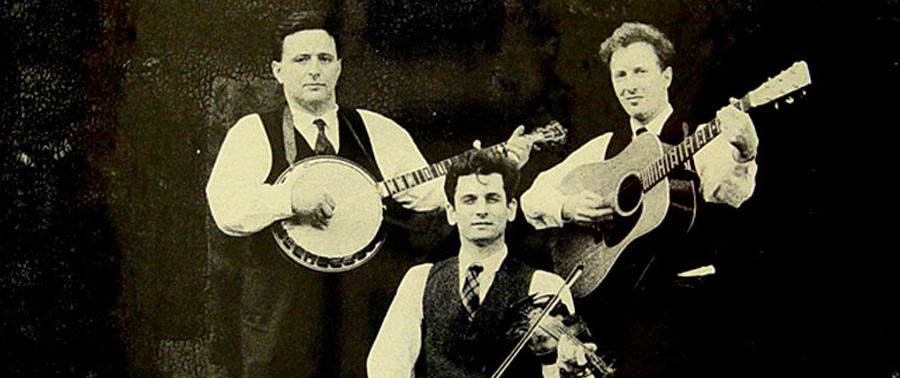
Tom Paley (top left) with the New Lost City Ramblers
This remembrance of the late Tom Paley is a contribution from James Reams.
I first met Tom Paley at a jam session during an old-time fiddle festival in Brooklyn. I didn’t recognize him until he started playing. That was about 1990, and I had just started performing in the NYC area with a terrific fiddler named Bill Christophersen. I was so blown away that I had just gotten to jam with one of my long-time idols from the New Lost City Ramblers, that I almost let the opportunity to talk with him slip through my fingers. Somehow I got up the courage to ask him if he wanted to grab a bite to eat (little knowing that curry was this super hero’s Kryptonite!). He must have seen my passion for this music as we talked over plates of great Indian food, because that’s the only explanation I have for why he agreed to record some songs with two young old-time bluegrass musicians from Brooklyn.
Even though Tom was living in England by then, he did make regular trips back to the States and we were able to gather enough songs over a six-year period to put together an album, and The Mysterious Redbirds was released by Copper Creek Records in 2000. The recording sessions were definitely not up to the standards for a legend like Tom Paley. We recorded live with minimal manipulation.
Our first recording session took place in the basement of an old brownstone. During winter months, the radiators would kick on with clanks and bangs causing us to have to stop recording until they went off again. The next two sessions were at Hank Bones’ studio on the 6th floor of a walkup (the elevator was permanently broken!). There was no A/C or fan in the studio and it was hot! We had this tube going between the engineering room and the recording room and during breaks in recording the engineer would hold up a desk fan to the tube to blow fresh air into our area. But Tom never complained and, in fact, kept us all laughing with his incredible talent for puns.
When Tom would come to New York, he would often stay at my house in Brooklyn. He wasn’t much for taking in the culture, preferring to stay “home” and play his music. I learned so much from those daily sessions. He would sit me down and teach me some of his favorite Swedish fiddle tunes. These polskas featured ¾ time, non-tempered intervals that made accompaniment on the guitar particularly difficult. I think those practices gave me a love for the crooked tunes of old-time music.
Tom’s three-finger style banjo picking was a rarity among old-time musicians and a nod to his inspiration, Uncle Dave Macon. Like Uncle Dave, Tom had some quirky habits too, like using a bungee cord for his banjo strap, stuffing his banjo head with undergarments, and carrying around extra picks in an old banged up tin box. But when he picked up that banjo and started playing, you knew you were in the presence of greatness. Tom’s rhythmatic picking had a snap to it – it was always clean and crisp. Although his first love was definitely the banjo, not many folks know that Tom also sold fiddles. In fact, Bill Christophersen, my long-time friend and collaborator on The Mysterious Redbirds, bought one of Tom’s fiddles and still uses it today.
Although I kept in touch with Tom, I hadn’t had the pleasure of getting to sit down with him personally since I moved to the southwest. The last time I saw Tom was in 2008 when he flew to NYC for a special concert that I had organized as part of the Park Slope Bluegrass and Old-time Music Jamboree. It just so happened that the Jamboree was scheduled for the exact date that the New Lost City Ramblers had performed together for the very first time, 50 years ago. Tom was joined by fellow bandmate, John Cohen and accompanied by Bill Christophersen on fiddle for this special 50th Anniversary Reunion. The concert was pure magic and transported all of us back to that wonderful hey dey of folk music.
It was truly an honor to be able to perform and record with this legendary folk hero. He taught me so much and I am grateful for the blessing of his friendship. One of the things that Tom continually pressed upon me was that performers should use themselves to present the music and not the other way around. I’ve tried to live by that creed throughout my 25-year career as a bluegrass musician. I hope I’ve done Tom proud.







